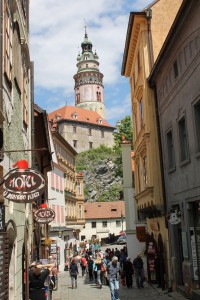Ceský Krumlov
On our route to Ceský Krumlov we visited the Vojna Memorial near Pribram. This former prison camp was set up in 1947-49 for German war prisoners, later it served as a labor camp in 1949-1951, and then converted to a prison for political opponents of the Communist regime in 1951-1961. Inmates were forced to work in the uranium mines. In 1950, 530 people were working here but by 1956 there were 1517 prisoners. It is sobering to see the inhumane treatment during that period while at the same time realizing that today humans still treat others in the most barbaric way.
We stopped for lunch in the small town of Pisek. It was the last day of the town festival featuring sand sculptures. (Pisek means sand in the Czech language.)
Ceský Krumlov is a picturesque town nestled inside a narrow loop of the Vltava River with a hilltop castle. Celts first settled here a century before Christ. Then German tribes, and then Slavic tribes in the ninth century. The Rozmberks ran the city from 1302 to 1602. The Habsburgs followed bringing in the Germanic period until 1945 when the Germans were expelled. The town is a mix of Gothic, Renaissance, and Baroque buildings. After settling into our hotel on the town square, we enjoyed dinner and an introduction to traditional Czech dances.
The Krumlov Castle is immense and includes bear pits, a rare Baroque theater (which we could not visit), and groomed gardens. The Round Tower marks the location of the first castle; Sally Jo climbed its 162 steps to see the town from the top.. The Castle Gardens are large with the lower part geometrical and the upper part rougher. There is a modern outdoor theater with a rotating seating area. The Museum has many exhibits of the life of nobility.
In the afternoon we took a rafting excursion along the Vltava River. We paddled about three miles along the gentle waters and through three weirs that went around shallow rapids.
We visited Zlata Koruna (Golden Crown) Monastery, a former abbey founded in 1263 and is Czech Republic’s best preserved Cistercian monastery located a short distance from Ceský Krumlov. At one point it was used as a factory but has been/is being restored. Beautiful frescos, gold images, Rococo paintings. We continued on to see where there had been a Celtic settlement in the 6th century. And from there we hiked about 2 ½ mile round trip to explore Hrad Divci Kamen, a ruined 13th century castle.
One afternoon we went on an hour horseback ride through the forest and meadows surrounding Klet Moutain, the tallest mountain nearby. We ended the ride with a picnic, roasting sausages over a bonfire.
We ended our time in Ceský Krumlov by visiting a home where the family is trying to live simply. They have no TV or radio and use very little electricity. They have a wood stove in the kitchen and use wood for heating their living space. They are slowly renovating their 1614 property which had originally been a mill. They grow much of their food.
- Vojna Memorial
- Vojna Memorial
- Vojna Memorial
- Pisek bridge
- Pisek sand sculpture
- Our hotel in Cesky Krumlov
- View from our bedroom
- View from our bedroom
- Traditional dancers
- Street view of castle tower
- Castle bear
- Revolving theatre seating
- Castle gardens
- Royal commodes
- Royal dinner table
- Gold jewelry
- Castle tower
- View from tower
- View from tower
- View from tower
- Rafting on Vltava River
- Rafting over weir
- Rafting on Vltava River
- Zlata Koruna Monastery
- Zlata Koruna Monastery
- Monastery ceiling
- Monastery church
- Orientation to Celtic settlement
- Walking to 13th century castle
- Near 13th century castle
- Hrad Divci Kamen
- Hrad Divci Kamen
- Horseback riding
- Horseback riding
- Horseback riding
- Barbeque after the ride
- Former mill turned home
- Former mill turned home
- Simple living
- Simple living









































